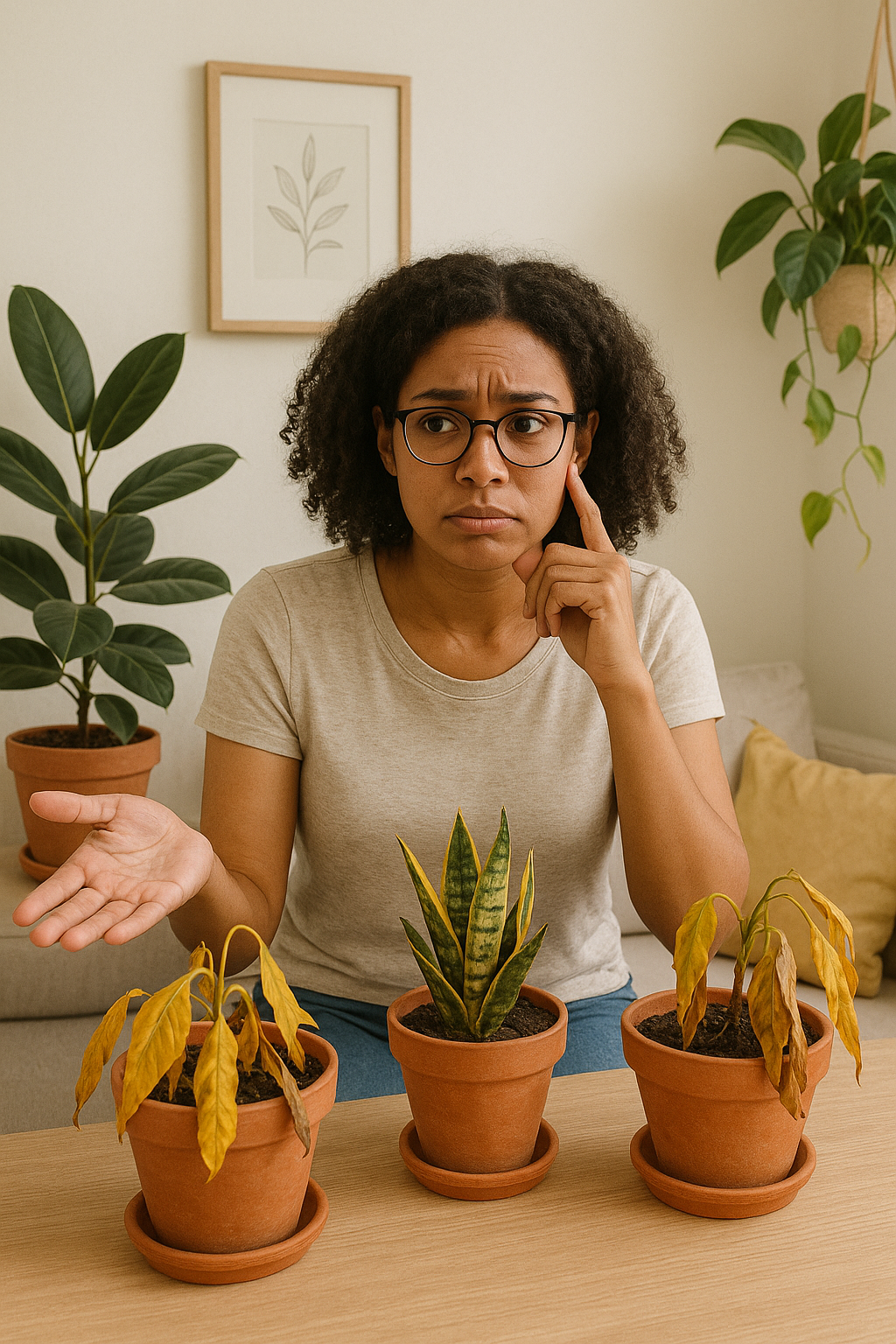Even with the best intentions and careful routines, apartment plants can sometimes run into trouble. From yellowing leaves to pests and mold, problems can sneak up on even the most attentive plant lovers. But don’t worry—most plant issues are easily reversible if caught early.
In this guide, we’ll walk you through how to identify and treat the most common problems faced by indoor plants in apartments. With these tips, you can bring struggling plants back to health and prevent future issues.
1. Yellowing Leaves
What It Means:
Yellow leaves are one of the most common signs that something is wrong—but the cause can vary.
Possible Causes:
- Overwatering: Roots become waterlogged and can’t get oxygen.
- Underwatering: The plant is dehydrated and shedding older leaves.
- Nutrient deficiency: Especially nitrogen.
- Lack of light: Especially for light-loving plants.
- Natural aging: Sometimes lower leaves just die off.
What to Do:
- Check the soil moisture. If it’s soggy, hold off on watering and let the soil dry out.
- Trim yellow leaves to redirect energy to healthy growth.
- Make sure the plant is in proper light for its species.
- Use a balanced, diluted fertilizer if the plant hasn’t been fed in a while.
2. Brown Leaf Tips or Edges
What It Means:
Dry or brown tips usually indicate stress, particularly from environmental conditions.
Possible Causes:
- Low humidity: Common in air-conditioned apartments.
- Underwatering
- Overfertilization
- Salt buildup from tap water
What to Do:
- Mist your plants or use a humidity tray.
- Cut off the brown tips with sterilized scissors (don’t cut into the green part).
- Use filtered or distilled water if tap water has high salt or chlorine content.
- Flush the soil occasionally by watering thoroughly and letting it drain completely.
3. Drooping or Wilting
What It Means:
A drooping plant looks sad, but the cause could be either too much water or not enough.
Possible Causes:
- Underwatering: Dry soil and crispy leaves.
- Overwatering: Mushy stems, soggy soil.
- Temperature shock
What to Do:
- Check the moisture level. Dry? Water it. Wet? Let it dry out.
- Avoid placing your plants near heating vents or drafty windows.
- If you recently moved the plant, give it a few days to adjust.
4. Mold or Fungal Growth in Soil
What It Means:
Mold isn’t usually harmful to the plant itself but signals that conditions are too moist or poorly ventilated.
What to Do:
- Remove the top layer of moldy soil and replace it with fresh, dry potting mix.
- Improve air circulation around the plant.
- Reduce watering frequency and ensure proper drainage.
If fungus persists, repot the plant entirely using sterile tools and fresh soil.
5. Pest Infestation (Gnats, Spider Mites, Mealybugs)
Signs:
- Fungus gnats: Tiny black flies hovering around the soil.
- Spider mites: Webbing on leaves and speckled yellow damage.
- Mealybugs: White, cotton-like clumps on stems or leaves.
What to Do:
- Gnats: Let soil dry out, add a layer of sand, or use yellow sticky traps.
- Spider mites: Rinse leaves thoroughly and use neem oil or insecticidal soap.
- Mealybugs: Remove manually with a cotton swab dipped in alcohol, then treat with neem oil.
Early intervention is key—check your plants regularly to stop pests before they spread.
6. Leaves Falling Off
What It Means:
Sudden leaf drop can be alarming, especially when it seems random.
Possible Causes:
- Sudden environmental change (light, temperature, location)
- Shock from repotting
- Overwatering or underwatering
What to Do:
- Identify any recent changes and try to reverse them.
- Make changes to care routines gradually.
- Be patient—plants often recover once stabilized.
7. No New Growth
If your plant hasn’t produced any new leaves for weeks or months, it may be in a dormant phase—or something could be wrong.
Possible Causes:
- Lack of nutrients
- Insufficient light
- Stress or poor soil quality
What to Do:
- Feed with a balanced liquid fertilizer.
- Move the plant to a brighter spot.
- Check if roots are compacted and consider repotting with fresh soil.
8. Leggy or Stretching Plants
What It Means:
Leggy plants grow tall and thin with big gaps between leaves. This is a common issue in low-light apartments.
What to Do:
- Move the plant to a brighter location or supplement with grow lights.
- Pinch back new growth to encourage bushier growth.
- Rotate the plant regularly to keep it growing evenly.
9. White Crust on Soil or Pots
What It Means:
This is usually a mineral or salt buildup from hard tap water or fertilizer.
What to Do:
- Scrape off the top layer of soil and replace it.
- Flush the soil by running water through the pot and letting it drain completely.
- Use distilled water or let tap water sit out overnight before using.
Preventative Tips to Keep Plants Healthy
- Inspect plants weekly: Check for pests, soil moisture, and overall appearance.
- Dust leaves monthly: Clean leaves help plants photosynthesize properly.
- Use proper pots: Ensure all containers have drainage holes.
- Don’t over-care: Most indoor plants prefer benign neglect over too much attention.
- Rotate your plants: Help them grow evenly and avoid leaning toward light sources.
Final Thought: Healthy Plants Start with Attention
Apartment plant care doesn’t have to be complicated—but it does require observation. By learning the early signs of trouble and acting quickly, you can fix most problems before they harm your plant.
Just like people, plants have different personalities and sensitivities. With a little attention and the right responses, you can keep your indoor jungle thriving—even when the occasional issue pops up.
